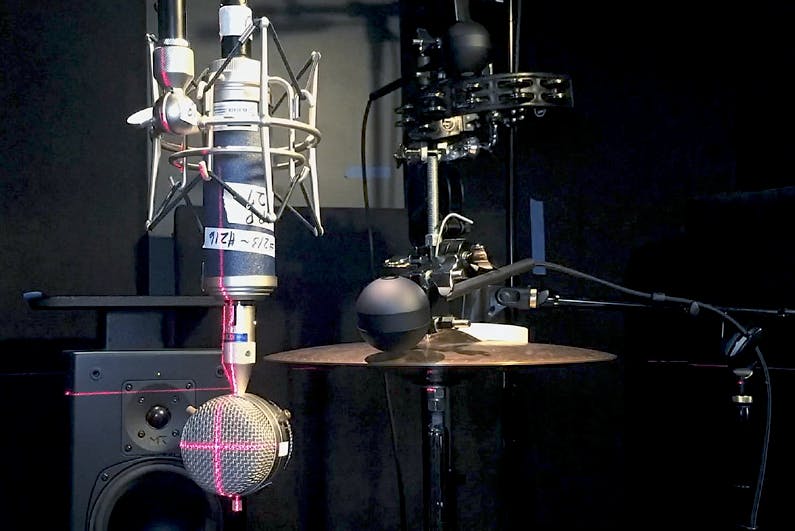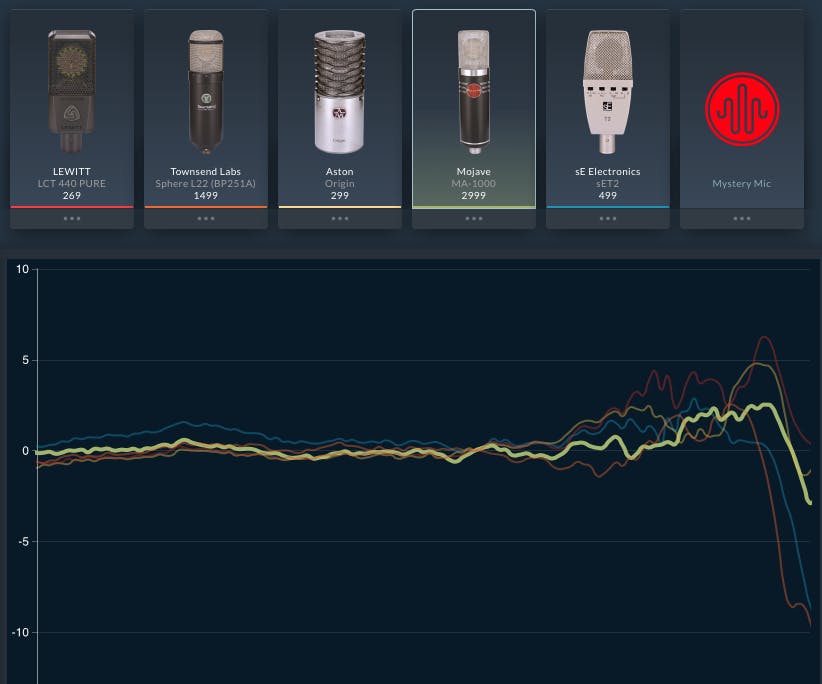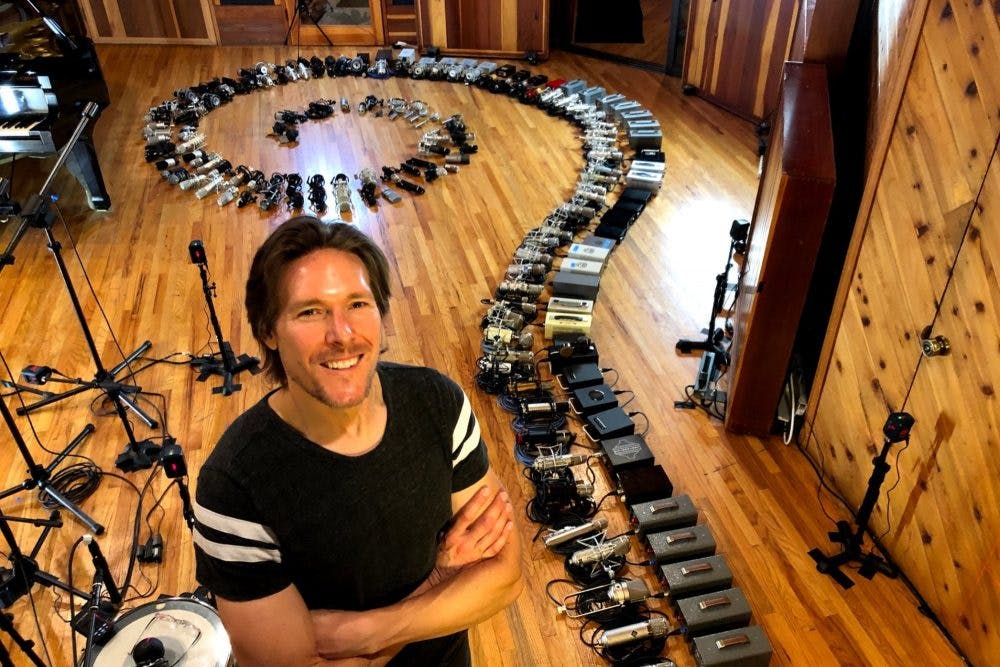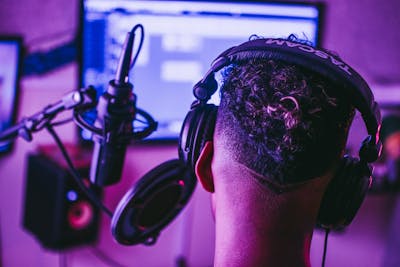Alex Oana and his team have developed a unique platform that allows you to audition and compare the sound of audio products in your own environment. AudioTestKitchen.com is their creation, a website where you can audition hundreds of microphones from the comfort of your home and, more importantly, within the familiar setting of your own monitors or headphones. Right now Audio Test Kitchen provides standardized recordings captured by large-diaphragm microphones, but soon ATK will feature other audio gear, like preamps, processors, and even plugins and instruments.
“Try before you buy” is a great motto when it comes to purchasing instruments, monitors, microphones, etc. The best way to choose a microphone is to use that microphone in your studio, on your voice, through your monitors. You can experiment on your own time, with your own setup, to learn how a microphone works for you in various positionings, on various songs and with your favorite processing. Unfortunately, we can’t simply go out to our local music store and take home dozens, or even a few, microphone brands and models to audition them. You could rent some time at a studio like Blackbird or East-West, where they have dozens, if not hundreds, of microphones, but you are still limited to their stock, which may not represent the models you wish to audition.
Alex came up with a solution: simply record dozens of audio sources through a pristine signal path with every microphone they could get their hands on to create a library of recordings that visitors can listen to. Easier said than done is the understatement of the century! How do you record a snare drum or a vocal with hundreds of microphones so that the performance, mic placement, gain-staging, and all other variables are virtually the same? Well, the audio nuts at ATK made it their goal to do just that.

To create a useful library of samples, the Audio Test Kitchen team used robotic drummers, calibrated playback speakers, and laser alignment systems that were developed in order to create a scientific method for recording consistent sources with all the microphones they could acquire. The recording process provided challenges like creating the exact same performance over and over again and recording with each mic diaphragm positioned at precisely the same physical position through the same signal path with equal gain. Along the way, Alex and Ian consulted with experts in audio testing, robotics, and music encoding technologies, all of whom generously offered up their expertise, products, and facilities. The recording and encoding methods for ATK employed could fill an entire article, and you can find out more about that in this terrific video produced by Sound on Sound.
So What is Audio Test Kitchen?
In a nutshell, Audio Test Kitchen (ATK) is a free, easily searchable database of musical instrument and vocal recordings that enables users to confidently compare the sound of a huge number of microphones, and soon other audio products. The material provided for each microphone includes recordings of solo instruments and voice, as well as multitrack recordings made with the same mic on every source. This so-called “stacked effect” naturally amplifies the unique qualities of each microphone, enabling users to even more clearly discern the character differences between various mics. In many cases, links to commercial recordings made with a particular microphone can be immediately auditioned via Spotify integration within the ATK web app.
What ATK is not is a store. Their goal is not to sell or promote any specific gear, but to present the sound of the gear to users who can not otherwise get their hands on the gear before making a purchase or planning a recording session. The site has zero bias in what it presents—each mic captures the same source(s) exactly the same way. The visitor can confidently compare and contrast any mics they choose.
Sonarworks is especially excited to work with Audio Test Kitchen because accurate and consistent monitoring falls squarely in line with ATK’s goal of presenting truly fair and accurate representations of audio signals. Trusting your monitors or headphones to provide accurate sound is a critical foundation for making any kind of reliable sonic comparisons. You don’t want to second-guess what you are hearing when committing to a purchase as important as, for example, your main vocal mic. Even listening to microphones at a first-class recording studio is a foreign environment to most of us and it can take hours or days to “normalize” our hearing to properly interpret the monitor system in such a new room. At last, ATK makes it possible for you to perform comparisons on your own monitor system. Sonarworks Reference 4 and Headphone software contribute to creating the accurate monitoring environment we rely on.

All About ATK
Alex Oana’s background includes decades spent as a recording and mix engineer, record producer, and business leader in innovative pro audio products before founding Audio Test Kitchen. Alex and I met over ZOOM recently to discuss this ambitious project and I want to share some of our conversation with our readers. As an engineer, product designer, and writer, I am extremely interested in the nuts and bolts of ATK and I think knowing a bit about their methods and goals will impress upon you how this site will benefit you in your future purchases.
AK: What were you thinking when you came up with Audio Test Kitchen?
Alex: If we could somehow teleport every microphone that you might be contemplating into your own studio, the kind of conditions that you would need in order to create a “fair fight” between those mics, like level-matching and source-matching, are extremely difficult. When comparing microphones on a singer, the thing you fall in love with might be an aspect of a specific performance, rather than a particular microphone.
Having run a bunch of mic shootouts, both in the studio and at Vintage King Audio in Los Angeles, one of just a few showrooms in the world where you can do a great comparison of many microphones, I observed some behaviors and buying habits. People often save up and buy the one best thing they can afford, be it a vocal mic, preamp, or whatever. They would not end up recording just vocals with that mic—they would record acoustic guitar, drum overheads, and maybe percussion, or they’d swing it over to the piano. The thing that people need to hear from a microphone is what I call “the sound of ownership.” What would it be like to have this mic and record everything on it?
I combined the idea of the “takeaway,” where you bring a mic to your own studio and use it for a few days on many things, together with the idea of an idealized showroom demo in which all the variables are controlled into what Audio Test Kitchen calls the “Stacked Effect.” That is, the opportunity to hear a microphone on all those instruments at the same time. We created the audio content on ATK to reveal the “true nature” of all these microphones. Multiple vocals, different genres, something really loud, quiet, deep, bright, etc. Combine all these sources, tracked with the same mic, and you get to know what the mic is really going to sound like. It’s the sound of ownership. So on our website, you can toggle between a mic solo’d on a source or hear the Stacked Effect of the mic on all the sources in a production at once.
Many mics may sound very similar on a given source, but the Stacked Effect gives a natural 10x magnification of the differences between mics that reveal the personality of the mic. Additionally, we enable the user to toggle between two versions of the Stacked Effect: a totally dry, unprocessed version, and a processed version. The processed version demonstrates how each mic holds up in a real mix with typical plugins and treatments; in this case UAD plugins.
AK: How complex are the arrangements for the stacked versions of the mic recordings?
Alex: Ten instruments is the max for any of the songs, including background vocals and any individual instruments. We also decided to do four genres of music, so four different songs. Just for those mics and four songs, with over 250 microphones and 50+ modeling microphones (and counting), we’ve got over 15,000 audio samples. Our Pro Tools sessions are crazy! It’s taken two-and-a-half years for us to get from our original idea to a presentable website. We are continuing to release new samples and songs.
Also, we are about to turn on a feature whereby a listener can hear a specific song that was recorded using a specific microphone. We link to a song on Spotify that is suggested to us by a manufacturer for a commercial song that actually used a specific vocal mic, for instance. The manufacturers only know so much about who is using their gear on what, so we’re going to further tap into the knowledge and experience of our user base to flesh out even more of this data and shine a light on independent engineers’ great work.
AK: What are some of the challenges of providing useful audio samples and how do you solve them?
Alex: Audio Test Kitchen and Sonarworks are really aligned in that both of us understand that we need The Truth, a consistent scientific process to ensure that all the audio is equally matched, and we also need Your Truth, which involves your aesthetic and taste. With Sonarworks The Truth is about monitoring accuracy, which allows you to fully express Your Truth—your artistic expression—in a meaningful way. Both ATK and Sonarworks have to create a true reference point so a creator can be sure the world hears things in the way a creator meant them to sound. Microphones are tools—filters really—that capture audio and color it during that process. We want to create a resource to help users accurately judge and find microphones that sound good to them.
Our scientific process of creating audio material and capturing it with all the microphones in exactly the same way provides that reference that removes all the performance and other variables from multiple audio samples.
AK: Tell us about Audio Test Kitchen’s curated system whereby visitors can describe what features are important to them; price, frequency response, brand name, etc. and the website will provide suggested solutions and audio examples to fit that need.
Alex: We want a system where the visitor can define the parameters of a product, in this case microphones, that they are looking for and we can build a cupboard of mics that fit their requirements. This helps narrow down the choices but maintains an unbiased decision-making process. We present no bias towards any product or brand because our process is so well-regulated. We are simply letting the user decide what sound they prefer for any particular device.
We started with large-diaphragm condenser mics, but our method is applicable to any type of gear—and that’s where we are headed. There’s such a need for more information about all kinds of audio tools and musical instruments. Plugins and digital tools really intrigue us. We want to be able to compare all of these tools in meaningful ways.
AK: What quality audio can the visitors expect to hear from your examples?
ATK: Audio files are produced at 96kKz, 32-bit. We had to strike a balance between resolution and useability for the website user, so right now we stream the highest quality mp3. We do try to pre-load what we predict the visitor will want to hear so that the experience is as responsive as possible. We are aware that the differences between two microphones may fall into that last few percent of quality and an mp3 might not fully reveal the finest details. So, we are working with an audio lab that has created a method for us to deliver full resolution audio at a highly-efficient streaming rate and we hope to start using that codec soon.
AK: Now that you have about 250 mics tested, do you have a plan to keep adding new mics?
Alex: in a sense, this first library of 250 physical microphones is a one-time creation that is a bit closed-ended. Because we don’t yet own our own facility, we don’t have our own stations setup to run consistent, standardized tests to add mics to our library. Our next step is to put together our own facility so we can quickly and accurately add mics and other devices to our database and keep up with user demand. We believe audio creators deserve access to the information needed to make informed decisions about purchases and equipment selections for creating our art.
Be sure to visit our friends at www.AudioTestKichen.com for more information.


